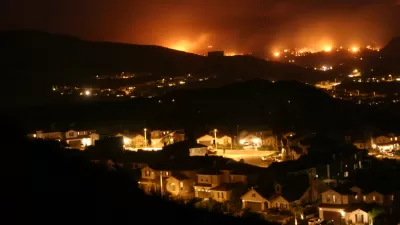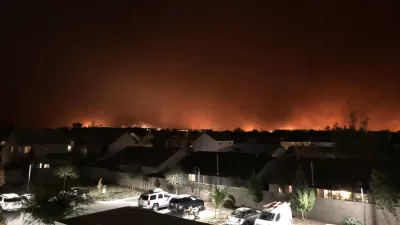PG&E announced that it is filing for Chapter 11 bankruptcy, facing $30 billion in liability after two years of catastrophic wildfires in the state of California.

"Citing 'extraordinary challenges' from the devastating 2017 and 2018 California wildfires, PG&E said Monday that it will file for Chapter 11 bankruptcy protection," reports Levi Sumagaysay.
"In a filing with the Securities and Exchange Commission, the utility that serves 16 million Californians gave the 15-day notice required by law for filing for bankruptcy" adds Sumagaysay. "The company’s stock dropped by more than half Monday in response to the early-morning announcement."
In a follow up article, Sumagaysay reported that PG&E had placed barricades around its San Francisco headquarters to usher employees to and from the building after the announcement. "The utility would not say whether any executives or employees had received threats, but there were about a dozen guards visible outside the company’s buildings Monday afternoon," according to Sumagaysay.
Another article by Janie Har and Cathy Bussewitz for the Associated Press provides additional details on the bankruptcy proceedings, placing the utility's potential liability from lawsuits connected to the wildfires of 2017 and 2018 at $30 billion.
An article by Mark Chediak and Kiel Porter reports on the resignation of Geisha Williams, the company's chief executive officer. General Counsel John Simon will act as interim CEO.
Another article by Umair Irfan calls the bankruptcy a sign of the effects of climate change: "the fall of a major utility is also a chilling example of how the impacts of climate change can pummel US companies and taxpayers right now. And the risks are only growing."
Additional news coverage on the bankruptcy is available on sites like Bloomberg, Reuters, and the Wall Street Journal.
FULL STORY: PG&E to file for bankruptcy due to wildfire lawsuits; shares tank

Planetizen Federal Action Tracker
A weekly monitor of how Trump’s orders and actions are impacting planners and planning in America.

Maui's Vacation Rental Debate Turns Ugly
Verbal attacks, misinformation campaigns and fistfights plague a high-stakes debate to convert thousands of vacation rentals into long-term housing.

Restaurant Patios Were a Pandemic Win — Why Were They so Hard to Keep?
Social distancing requirements and changes in travel patterns prompted cities to pilot new uses for street and sidewalk space. Then it got complicated.

In California Battle of Housing vs. Environment, Housing Just Won
A new state law significantly limits the power of CEQA, an environmental review law that served as a powerful tool for blocking new development.

Boulder Eliminates Parking Minimums Citywide
Officials estimate the cost of building a single underground parking space at up to $100,000.

Orange County, Florida Adopts Largest US “Sprawl Repair” Code
The ‘Orange Code’ seeks to rectify decades of sprawl-inducing, car-oriented development.
Urban Design for Planners 1: Software Tools
This six-course series explores essential urban design concepts using open source software and equips planners with the tools they need to participate fully in the urban design process.
Planning for Universal Design
Learn the tools for implementing Universal Design in planning regulations.
Heyer Gruel & Associates PA
JM Goldson LLC
Custer County Colorado
City of Camden Redevelopment Agency
City of Astoria
Transportation Research & Education Center (TREC) at Portland State University
Jefferson Parish Government
Camden Redevelopment Agency
City of Claremont





























